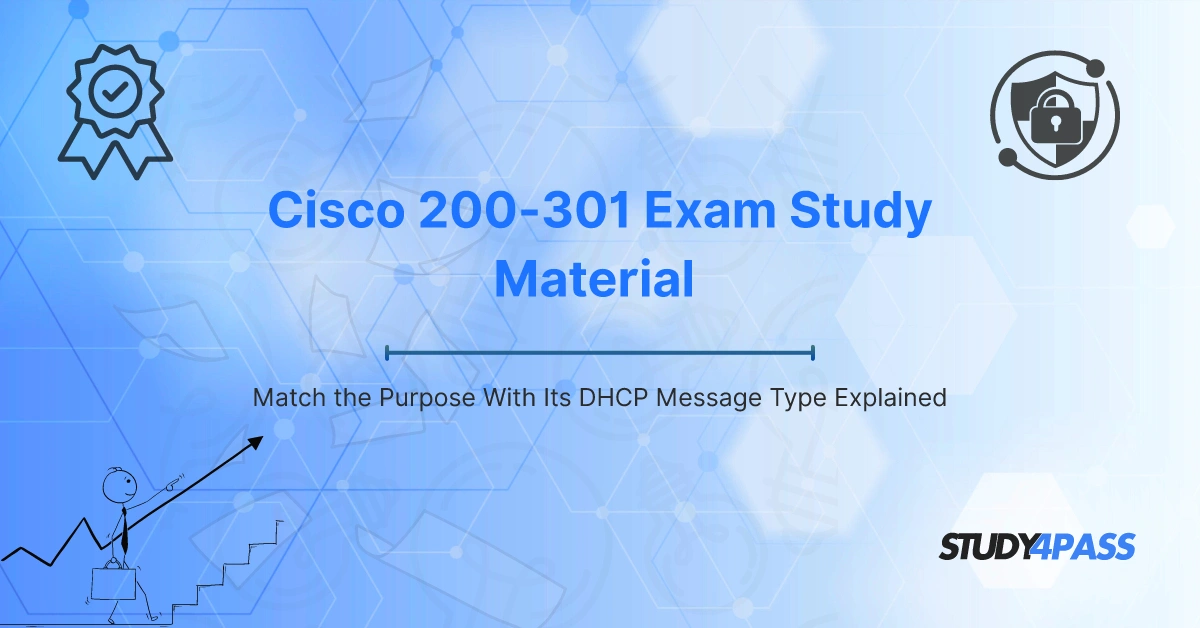Introduction
Dynamic Host Configuration Protocol (DHCP) is a critical network protocol used to automatically assign IP addresses and other network configuration parameters to devices on a network. Understanding DHCP message types is essential for network administrators, especially those preparing for the Cisco Certified Network Associate (CCNA) 200-301 exam. This article explores different DHCP message types, their purposes, and how they function in a network environment.
For comprehensive CCNA, CCDA, CCENT, CCNA Security, and CCNA Wireless study materials, visit Study4Pass, a trusted platform for Cisco certification preparation.
Understanding DHCP and Its Role in Networking
DHCP simplifies IP address management by dynamically allocating addresses to devices, eliminating the need for manual configuration. The DHCP process involves several message exchanges between a client and a DHCP server. Each message type serves a specific purpose in the IP assignment process.
Key DHCP Message Types
Below are the primary DHCP message types and their purposes:
| DHCP Message Type | Purpose |
|---|---|
| DHCP Discover | Broadcast by a client to locate available DHCP servers. |
| DHCP Offer | Sent by a DHCP server in response to a Discover message, offering an IP address. |
| DHCP Request | Sent by the client to request the offered IP address from a DHCP server. |
| DHCP Acknowledgment (ACK) | Final confirmation from the server, assigning the IP address to the client. |
| DHCP Negative Acknowledgment (NACK) | Sent by the server if the requested IP is no longer available. |
| DHCP Release | Sent by a client to relinquish its IP address before lease expiration. |
| DHCP Decline | Sent by a client if it detects that the offered IP is already in use. |
| DHCP Inform | Used when a client has an IP but needs additional configuration (e.g., DNS, gateway). |
Detailed Explanation of DHCP Message Types
1. DHCP Discover
-
Purpose: A client broadcasts this message to discover available DHCP servers.
-
Usage Scenario: When a device (e.g., laptop) connects to a network, it sends a DHCP Discover packet to find a DHCP server.
2. DHCP Offer
-
Purpose: The DHCP server responds with an Offer, proposing an available IP address.
-
Usage Scenario: The server reserves an IP and sends configuration details (subnet mask, gateway, DNS).
3. DHCP Request
-
Purpose: The client formally requests the offered IP address.
-
Usage Scenario: The client may receive multiple offers but selects one and sends a Request to confirm.
4. DHCP Acknowledgment (ACK)
-
Purpose: The server finalizes the lease and confirms the IP assignment.
-
Usage Scenario: Once the server sends an ACK, the client can use the IP address.
5. DHCP Negative Acknowledgment (NACK)
-
Purpose: The server denies the request if the IP is no longer available.
-
Usage Scenario: If a client requests an invalid or leased IP, the server sends a NACK, forcing the client to restart the process.
6. DHCP Release
-
Purpose: The client voluntarily releases its IP before lease expiration.
-
Usage Scenario: Useful when a device disconnects from the network gracefully.
7. DHCP Decline
-
Purpose: The client rejects an IP address if it detects a conflict.
-
Usage Scenario: If a client finds the offered IP already in use (via ARP), it sends a Decline message.
8. DHCP Inform
-
Purpose: Used when a client has a static IP but needs additional DHCP options.
-
Usage Scenario: A device with a manually configured IP may request DNS or gateway details via Inform.
DHCP Message Exchange Process (DORA)
The standard DHCP process follows the DORA sequence:
-
Discover – Client searches for DHCP servers.
-
Offer – Server proposes an IP address.
-
Request – Client accepts the offer.
-
Acknowledgment (ACK) – Server confirms the lease.
If any step fails, the client may restart the process or use NACK/Decline messages to resolve conflicts.
Why Understanding DHCP is Crucial for CCNA 200-301 Exam?
The CCNA 200-301 exam tests candidates on DHCP operations, including:
-
How DHCP assigns IP addresses.
-
The role of different DHCP messages.
-
Troubleshooting DHCP-related issues.
Mastering DHCP concepts ensures success in network configuration and troubleshooting scenarios.
Study4Pass – Your Ultimate CCNA Preparation Resource
For those preparing for CCNA, CCDA, CCENT, CCNA Security, or CCNA Wireless, Study4Pass offers:
- Detailed Study Guides – Covering all exam objectives.
- Practice Exams – Simulating real Cisco test environments.
- Hands-on Labs – For practical DHCP and networking experience.
- Expert Explanations – Clarifying complex topics like DHCP messaging.
Visit Study4Pass today and accelerate your Cisco certification journey!
Conclusion
Understanding DHCP message types is essential for network professionals. By matching each message with its purpose, you can efficiently configure and troubleshoot DHCP in real-world networks. For comprehensive Cisco Certification Training, rely on Study4Pass for high-quality study materials and exam success.
By mastering DHCP and other networking fundamentals, you’ll be well-prepared for the CCNA 200-301 exam and beyond. Happy studying!
Special Discount: Offer Valid For Limited Time “200-301 Study Material”
Actual Exam Questions For Cisco's 200-301 Study Guide
Sample Questions For Cisco 200-301 Practice Test
1. Which DHCP message type is used by a client to locate available DHCP servers?
A. DHCPACK
B. DHCPDISCOVER
C. DHCPREQUEST
D. DHCPOFFER
2. What is the purpose of the DHCPACK message?
A. To assign a lease to the client
B. To inform the client that the offer is invalid
C. To request an IP address
D. To find available servers
3. Which DHCP message type is sent by the server to offer IP configuration to the client?
A. DHCPDECLINE
B. DHCPNACK
C. DHCPOFFER
D. DHCPRELEASE
4. When a client accepts an IP address offered by the server, which DHCP message does it send?
A. DHCPREQUEST
B. DHCPACK
C. DHCPOFFER
D. DHCPDECLINE
5. If a DHCP server determines that a client's requested configuration is invalid, which message will it send?
A. DHCPRELEASE
B. DHCPNACK
C. DHCPACK
D. DHCPDISCOVER

